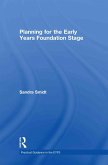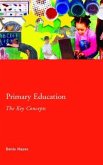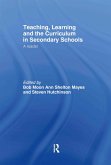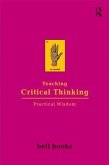- Gebundenes Buch
- Merkliste
- Auf die Merkliste
- Bewerten Bewerten
- Teilen
- Produkt teilen
- Produkterinnerung
- Produkterinnerung
First Published in 1998. Routledge is an imprint of Taylor & Francis, an informa company.
Andere Kunden interessierten sich auch für
![Parent Partnership in the Primary School Parent Partnership in the Primary School]() Nigel BishopParent Partnership in the Primary School174,99 €
Nigel BishopParent Partnership in the Primary School174,99 €![Planning for the Early Years Foundation Stage Planning for the Early Years Foundation Stage]() Sandra SmidtPlanning for the Early Years Foundation Stage174,99 €
Sandra SmidtPlanning for the Early Years Foundation Stage174,99 €![Primary Education Primary Education]() Denis HayesPrimary Education39,99 €
Denis HayesPrimary Education39,99 €![On the Write Track On the Write Track]() James ClementsOn the Write Track176,99 €
James ClementsOn the Write Track176,99 €![Don't Call It Literacy! Don't Call It Literacy!]() Geoff BartonDon't Call It Literacy!174,99 €
Geoff BartonDon't Call It Literacy!174,99 €![Teaching, Learning and the Curriculum in Secondary Schools Teaching, Learning and the Curriculum in Secondary Schools]() Steven Hutchinson / Bob Moon (eds.)Teaching, Learning and the Curriculum in Secondary Schools249,99 €
Steven Hutchinson / Bob Moon (eds.)Teaching, Learning and the Curriculum in Secondary Schools249,99 €![Teaching Critical Thinking Teaching Critical Thinking]() bell hooksTeaching Critical Thinking35,99 €
bell hooksTeaching Critical Thinking35,99 €-
-
-
First Published in 1998. Routledge is an imprint of Taylor & Francis, an informa company.
Hinweis: Dieser Artikel kann nur an eine deutsche Lieferadresse ausgeliefert werden.
Hinweis: Dieser Artikel kann nur an eine deutsche Lieferadresse ausgeliefert werden.
Produktdetails
- Produktdetails
- Verlag: Taylor & Francis Ltd (Sales)
- Seitenzahl: 164
- Erscheinungstermin: 27. Januar 2017
- Englisch
- Abmessung: 234mm x 156mm x 11mm
- Gewicht: 413g
- ISBN-13: 9781138160170
- ISBN-10: 1138160172
- Artikelnr.: 50187425
- Herstellerkennzeichnung
- Libri GmbH
- Europaallee 1
- 36244 Bad Hersfeld
- gpsr@libri.de
- Verlag: Taylor & Francis Ltd (Sales)
- Seitenzahl: 164
- Erscheinungstermin: 27. Januar 2017
- Englisch
- Abmessung: 234mm x 156mm x 11mm
- Gewicht: 413g
- ISBN-13: 9781138160170
- ISBN-10: 1138160172
- Artikelnr.: 50187425
- Herstellerkennzeichnung
- Libri GmbH
- Europaallee 1
- 36244 Bad Hersfeld
- gpsr@libri.de
Sally Brown, Carolyn Earlam, Phil Race
Part 1 Techniques for effective teaching and classroom management
Chapter 1 Meeting a class for the first time
Chapter 2 Gaining attention and settling a class down
Chapter 3 Coping with interruptions
Chapter 4 Learning names
Chapter 5 Avoiding disruption in your class
Chapter 6 Using blackboards
Chapter 7 Organizing practical lessons
Chapter 8 Doing yard/bus/break duties painlessly
Chapter 9 Ensuring equality of opportunity within your teaching
Chapter 10 Strategies for raising achievement
Part 2 Planning and assessment
Chapter 11 Assessing pupils' work
Chapter 12 Giving pupils face-to-face feedback
Chapter 13 Getting feedback from pupils
Chapter 14 Using self- and peer-assessment
Chapter 15 Making sense of new structures
Chapter 16 Planning schemes of work
Chapter 17 Invigilating internal exams
Chapter 18 Writing reports
Chapter 19 Preparing for an inspection
Part 3 Using teaching and learning resources well
Chapter 20 Preparing interesting handout materials
Chapter 21 Preparing learning packages
Chapter 22 Getting the most from the library
Chapter 23 Organizing resources
Chapter 24 Making do with limited resources
Chapter 25 Making your classroom into an attractive learning environment
Chapter 26 Making effective displays
Chapter 27 Taking pupils on a trip
Chapter 28 Visiting museums and art galleries
Part 4 Supporting pupils' learning
Chapter 29 Helping pupils who don't read well
Chapter 30 Helping pupils who don't do maths well
Chapter 31 Helping pupils to learn together
Chapter 32 Helping pupils to revise effectively
Chapter 33 Helping pupils to pass exams
Chapter 34 Helping pupils to be creative
Chapter 35 Helping pupils to write essays
Part 5 Providing personal and pastoral care
Chapter 36 Being an effective Form Tutor
Chapter 37 Getting pupils to talk to you
Chapter 38 Helping pupils who don't believe in themselves
Chapter 39 Coping with emotional pupils
Chapter 40 Breaking bad news
Chapter 41 Helping pupils to recover from setbacks
Chapter 42 Helping pupils towards university or employment
Chapter 43 Coping with parents' evenings
Chapter 44 Dealing with difficult parents
Chapter 45 Coping with emergencies
Part 6 Being an effective colleague
Chapter 46 Working with colleagues
Chapter 47 Coping with difficult Heads of Department or senior staff
Chapter 48 Managing a department
Chapter 49 Covering for absent colleagues
Chapter 50 Coping with stress
Chapter 51 Planning your career progression
Chapter 52 Applying for jobs
Part 7 Information and communications technologies
Chapter 53 Choosing computer-aided learning packages
Chapter 54 Getting pupils used to the idea of learning from a machine
Chapter 55 Getting pupils used to mice and keyboards
Chapter 56 Finding out how computer-assisted learning is going
Chapter 57 Using e-mail to support learning
Chapter 58 Helping pupils to get started with e-mail
Chapter 59 Giving pupils feedback using e-mail
Chapter 60 Helping pupils to learn with computer conferencing
Chapter 61 Using video for learning
Chapter 62 Using audiotapes for learning
Chapter 63 Using multimedia packages for learning
Chapter 64 Using the Internet for learning
Chapter 65 Helping pupils to learn from the Internet
Chapter 1 Meeting a class for the first time
Chapter 2 Gaining attention and settling a class down
Chapter 3 Coping with interruptions
Chapter 4 Learning names
Chapter 5 Avoiding disruption in your class
Chapter 6 Using blackboards
Chapter 7 Organizing practical lessons
Chapter 8 Doing yard/bus/break duties painlessly
Chapter 9 Ensuring equality of opportunity within your teaching
Chapter 10 Strategies for raising achievement
Part 2 Planning and assessment
Chapter 11 Assessing pupils' work
Chapter 12 Giving pupils face-to-face feedback
Chapter 13 Getting feedback from pupils
Chapter 14 Using self- and peer-assessment
Chapter 15 Making sense of new structures
Chapter 16 Planning schemes of work
Chapter 17 Invigilating internal exams
Chapter 18 Writing reports
Chapter 19 Preparing for an inspection
Part 3 Using teaching and learning resources well
Chapter 20 Preparing interesting handout materials
Chapter 21 Preparing learning packages
Chapter 22 Getting the most from the library
Chapter 23 Organizing resources
Chapter 24 Making do with limited resources
Chapter 25 Making your classroom into an attractive learning environment
Chapter 26 Making effective displays
Chapter 27 Taking pupils on a trip
Chapter 28 Visiting museums and art galleries
Part 4 Supporting pupils' learning
Chapter 29 Helping pupils who don't read well
Chapter 30 Helping pupils who don't do maths well
Chapter 31 Helping pupils to learn together
Chapter 32 Helping pupils to revise effectively
Chapter 33 Helping pupils to pass exams
Chapter 34 Helping pupils to be creative
Chapter 35 Helping pupils to write essays
Part 5 Providing personal and pastoral care
Chapter 36 Being an effective Form Tutor
Chapter 37 Getting pupils to talk to you
Chapter 38 Helping pupils who don't believe in themselves
Chapter 39 Coping with emotional pupils
Chapter 40 Breaking bad news
Chapter 41 Helping pupils to recover from setbacks
Chapter 42 Helping pupils towards university or employment
Chapter 43 Coping with parents' evenings
Chapter 44 Dealing with difficult parents
Chapter 45 Coping with emergencies
Part 6 Being an effective colleague
Chapter 46 Working with colleagues
Chapter 47 Coping with difficult Heads of Department or senior staff
Chapter 48 Managing a department
Chapter 49 Covering for absent colleagues
Chapter 50 Coping with stress
Chapter 51 Planning your career progression
Chapter 52 Applying for jobs
Part 7 Information and communications technologies
Chapter 53 Choosing computer-aided learning packages
Chapter 54 Getting pupils used to the idea of learning from a machine
Chapter 55 Getting pupils used to mice and keyboards
Chapter 56 Finding out how computer-assisted learning is going
Chapter 57 Using e-mail to support learning
Chapter 58 Helping pupils to get started with e-mail
Chapter 59 Giving pupils feedback using e-mail
Chapter 60 Helping pupils to learn with computer conferencing
Chapter 61 Using video for learning
Chapter 62 Using audiotapes for learning
Chapter 63 Using multimedia packages for learning
Chapter 64 Using the Internet for learning
Chapter 65 Helping pupils to learn from the Internet
Part 1 Techniques for effective teaching and classroom management; Chapter 1 Meeting a class for the first time; Chapter 2 Gaining attention and settling a class down; Chapter 3 Coping with interruptions; Chapter 4 Learning names; Chapter 5 Avoiding disruption in your class; Chapter 6 Using blackboards; Chapter 7 Organizing practical lessons; Chapter 8 Doing yard/bus/break duties painlessly; Chapter 9 Ensuring equality of opportunity within your teaching; Chapter 10 Strategies for raising achievement; Part 2 Planning and assessment; Chapter 11 Assessing pupils' work; Chapter 12 Giving pupils face-to-face feedback; Chapter 13 Getting feedback from pupils; Chapter 14 Using self- and peer-assessment; Chapter 15 Making sense of new structures; Chapter 16 Planning schemes of work; Chapter 17 Invigilating internal exams; Chapter 18 Writing reports; Chapter 19 Preparing for an inspection; Part 3 Using teaching and learning resources well; Chapter 20 Preparing interesting handout materials; Chapter 21 Preparing learning packages; Chapter 22 Getting the most from the library; Chapter 23 Organizing resources; Chapter 24 Making do with limited resources; Chapter 25 Making your classroom into an attractive learning environment; Chapter 26 Making effective displays; Chapter 27 Taking pupils on a trip; Chapter 28 Visiting museums and art galleries; Part 4 Supporting pupils' learning; Chapter 29 Helping pupils who don't read well; Chapter 30 Helping pupils who don't do maths well; Chapter 31 Helping pupils to learn together; Chapter 32 Helping pupils to revise effectively; Chapter 33 Helping pupils to pass exams; Chapter 34 Helping pupils to be creative; Chapter 35 Helping pupils to write essays; Part 5 Providing personal and pastoral care; Chapter 36 Being an effective Form Tutor; Chapter 37 Getting pupils to talk to you; Chapter 38 Helping pupils who don't believe in themselves; Chapter 39 Coping with emotional pupils; Chapter 40 Breaking bad news; Chapter 41 Helping pupils to recover from setbacks; Chapter 42 Helping pupils towards university or employment; Chapter 43 Coping with parents' evenings; Chapter 44 Dealing with difficult parents; Chapter 45 Coping with emergencies; Part 6 Being an effective colleague; Chapter 46 Working with colleagues; Chapter 47 Coping with difficult Heads of Department or senior staff; Chapter 48 Managing a department; Chapter 49 Covering for absent colleagues; Chapter 50 Coping with stress; Chapter 51 Planning your career progression; Chapter 52 Applying for jobs; Part 7 Information and communications technologies; Chapter 53 Choosing computer-aided learning packages; Chapter 54 Getting pupils used to the idea of learning from a machine; Chapter 55 Getting pupils used to mice and keyboards; Chapter 56 Finding out how computer-assisted learning is going; Chapter 57 Using e-mail to support learning; Chapter 58 Helping pupils to get started with e-mail; Chapter 59 Giving pupils feedback using e-mail; Chapter 60 Helping pupils to learn with computer conferencing; Chapter 61 Using video for learning; Chapter 62 Using audiotapes for learning; Chapter 63 Using multimedia packages for learning; Chapter 64 Using the Internet for learning; Chapter 65 Helping pupils to learn from the Internet;
Part 1 Techniques for effective teaching and classroom management
Chapter 1 Meeting a class for the first time
Chapter 2 Gaining attention and settling a class down
Chapter 3 Coping with interruptions
Chapter 4 Learning names
Chapter 5 Avoiding disruption in your class
Chapter 6 Using blackboards
Chapter 7 Organizing practical lessons
Chapter 8 Doing yard/bus/break duties painlessly
Chapter 9 Ensuring equality of opportunity within your teaching
Chapter 10 Strategies for raising achievement
Part 2 Planning and assessment
Chapter 11 Assessing pupils' work
Chapter 12 Giving pupils face-to-face feedback
Chapter 13 Getting feedback from pupils
Chapter 14 Using self- and peer-assessment
Chapter 15 Making sense of new structures
Chapter 16 Planning schemes of work
Chapter 17 Invigilating internal exams
Chapter 18 Writing reports
Chapter 19 Preparing for an inspection
Part 3 Using teaching and learning resources well
Chapter 20 Preparing interesting handout materials
Chapter 21 Preparing learning packages
Chapter 22 Getting the most from the library
Chapter 23 Organizing resources
Chapter 24 Making do with limited resources
Chapter 25 Making your classroom into an attractive learning environment
Chapter 26 Making effective displays
Chapter 27 Taking pupils on a trip
Chapter 28 Visiting museums and art galleries
Part 4 Supporting pupils' learning
Chapter 29 Helping pupils who don't read well
Chapter 30 Helping pupils who don't do maths well
Chapter 31 Helping pupils to learn together
Chapter 32 Helping pupils to revise effectively
Chapter 33 Helping pupils to pass exams
Chapter 34 Helping pupils to be creative
Chapter 35 Helping pupils to write essays
Part 5 Providing personal and pastoral care
Chapter 36 Being an effective Form Tutor
Chapter 37 Getting pupils to talk to you
Chapter 38 Helping pupils who don't believe in themselves
Chapter 39 Coping with emotional pupils
Chapter 40 Breaking bad news
Chapter 41 Helping pupils to recover from setbacks
Chapter 42 Helping pupils towards university or employment
Chapter 43 Coping with parents' evenings
Chapter 44 Dealing with difficult parents
Chapter 45 Coping with emergencies
Part 6 Being an effective colleague
Chapter 46 Working with colleagues
Chapter 47 Coping with difficult Heads of Department or senior staff
Chapter 48 Managing a department
Chapter 49 Covering for absent colleagues
Chapter 50 Coping with stress
Chapter 51 Planning your career progression
Chapter 52 Applying for jobs
Part 7 Information and communications technologies
Chapter 53 Choosing computer-aided learning packages
Chapter 54 Getting pupils used to the idea of learning from a machine
Chapter 55 Getting pupils used to mice and keyboards
Chapter 56 Finding out how computer-assisted learning is going
Chapter 57 Using e-mail to support learning
Chapter 58 Helping pupils to get started with e-mail
Chapter 59 Giving pupils feedback using e-mail
Chapter 60 Helping pupils to learn with computer conferencing
Chapter 61 Using video for learning
Chapter 62 Using audiotapes for learning
Chapter 63 Using multimedia packages for learning
Chapter 64 Using the Internet for learning
Chapter 65 Helping pupils to learn from the Internet
Chapter 1 Meeting a class for the first time
Chapter 2 Gaining attention and settling a class down
Chapter 3 Coping with interruptions
Chapter 4 Learning names
Chapter 5 Avoiding disruption in your class
Chapter 6 Using blackboards
Chapter 7 Organizing practical lessons
Chapter 8 Doing yard/bus/break duties painlessly
Chapter 9 Ensuring equality of opportunity within your teaching
Chapter 10 Strategies for raising achievement
Part 2 Planning and assessment
Chapter 11 Assessing pupils' work
Chapter 12 Giving pupils face-to-face feedback
Chapter 13 Getting feedback from pupils
Chapter 14 Using self- and peer-assessment
Chapter 15 Making sense of new structures
Chapter 16 Planning schemes of work
Chapter 17 Invigilating internal exams
Chapter 18 Writing reports
Chapter 19 Preparing for an inspection
Part 3 Using teaching and learning resources well
Chapter 20 Preparing interesting handout materials
Chapter 21 Preparing learning packages
Chapter 22 Getting the most from the library
Chapter 23 Organizing resources
Chapter 24 Making do with limited resources
Chapter 25 Making your classroom into an attractive learning environment
Chapter 26 Making effective displays
Chapter 27 Taking pupils on a trip
Chapter 28 Visiting museums and art galleries
Part 4 Supporting pupils' learning
Chapter 29 Helping pupils who don't read well
Chapter 30 Helping pupils who don't do maths well
Chapter 31 Helping pupils to learn together
Chapter 32 Helping pupils to revise effectively
Chapter 33 Helping pupils to pass exams
Chapter 34 Helping pupils to be creative
Chapter 35 Helping pupils to write essays
Part 5 Providing personal and pastoral care
Chapter 36 Being an effective Form Tutor
Chapter 37 Getting pupils to talk to you
Chapter 38 Helping pupils who don't believe in themselves
Chapter 39 Coping with emotional pupils
Chapter 40 Breaking bad news
Chapter 41 Helping pupils to recover from setbacks
Chapter 42 Helping pupils towards university or employment
Chapter 43 Coping with parents' evenings
Chapter 44 Dealing with difficult parents
Chapter 45 Coping with emergencies
Part 6 Being an effective colleague
Chapter 46 Working with colleagues
Chapter 47 Coping with difficult Heads of Department or senior staff
Chapter 48 Managing a department
Chapter 49 Covering for absent colleagues
Chapter 50 Coping with stress
Chapter 51 Planning your career progression
Chapter 52 Applying for jobs
Part 7 Information and communications technologies
Chapter 53 Choosing computer-aided learning packages
Chapter 54 Getting pupils used to the idea of learning from a machine
Chapter 55 Getting pupils used to mice and keyboards
Chapter 56 Finding out how computer-assisted learning is going
Chapter 57 Using e-mail to support learning
Chapter 58 Helping pupils to get started with e-mail
Chapter 59 Giving pupils feedback using e-mail
Chapter 60 Helping pupils to learn with computer conferencing
Chapter 61 Using video for learning
Chapter 62 Using audiotapes for learning
Chapter 63 Using multimedia packages for learning
Chapter 64 Using the Internet for learning
Chapter 65 Helping pupils to learn from the Internet
Part 1 Techniques for effective teaching and classroom management; Chapter 1 Meeting a class for the first time; Chapter 2 Gaining attention and settling a class down; Chapter 3 Coping with interruptions; Chapter 4 Learning names; Chapter 5 Avoiding disruption in your class; Chapter 6 Using blackboards; Chapter 7 Organizing practical lessons; Chapter 8 Doing yard/bus/break duties painlessly; Chapter 9 Ensuring equality of opportunity within your teaching; Chapter 10 Strategies for raising achievement; Part 2 Planning and assessment; Chapter 11 Assessing pupils' work; Chapter 12 Giving pupils face-to-face feedback; Chapter 13 Getting feedback from pupils; Chapter 14 Using self- and peer-assessment; Chapter 15 Making sense of new structures; Chapter 16 Planning schemes of work; Chapter 17 Invigilating internal exams; Chapter 18 Writing reports; Chapter 19 Preparing for an inspection; Part 3 Using teaching and learning resources well; Chapter 20 Preparing interesting handout materials; Chapter 21 Preparing learning packages; Chapter 22 Getting the most from the library; Chapter 23 Organizing resources; Chapter 24 Making do with limited resources; Chapter 25 Making your classroom into an attractive learning environment; Chapter 26 Making effective displays; Chapter 27 Taking pupils on a trip; Chapter 28 Visiting museums and art galleries; Part 4 Supporting pupils' learning; Chapter 29 Helping pupils who don't read well; Chapter 30 Helping pupils who don't do maths well; Chapter 31 Helping pupils to learn together; Chapter 32 Helping pupils to revise effectively; Chapter 33 Helping pupils to pass exams; Chapter 34 Helping pupils to be creative; Chapter 35 Helping pupils to write essays; Part 5 Providing personal and pastoral care; Chapter 36 Being an effective Form Tutor; Chapter 37 Getting pupils to talk to you; Chapter 38 Helping pupils who don't believe in themselves; Chapter 39 Coping with emotional pupils; Chapter 40 Breaking bad news; Chapter 41 Helping pupils to recover from setbacks; Chapter 42 Helping pupils towards university or employment; Chapter 43 Coping with parents' evenings; Chapter 44 Dealing with difficult parents; Chapter 45 Coping with emergencies; Part 6 Being an effective colleague; Chapter 46 Working with colleagues; Chapter 47 Coping with difficult Heads of Department or senior staff; Chapter 48 Managing a department; Chapter 49 Covering for absent colleagues; Chapter 50 Coping with stress; Chapter 51 Planning your career progression; Chapter 52 Applying for jobs; Part 7 Information and communications technologies; Chapter 53 Choosing computer-aided learning packages; Chapter 54 Getting pupils used to the idea of learning from a machine; Chapter 55 Getting pupils used to mice and keyboards; Chapter 56 Finding out how computer-assisted learning is going; Chapter 57 Using e-mail to support learning; Chapter 58 Helping pupils to get started with e-mail; Chapter 59 Giving pupils feedback using e-mail; Chapter 60 Helping pupils to learn with computer conferencing; Chapter 61 Using video for learning; Chapter 62 Using audiotapes for learning; Chapter 63 Using multimedia packages for learning; Chapter 64 Using the Internet for learning; Chapter 65 Helping pupils to learn from the Internet;








